Introduction
In the fast-paced world of software development, the key to long-term success lies in the principles of clean code. Clean code is not just a stylistic choice but a fundamental practice that ensures readability, maintainability, and overall efficiency in coding projects. By adhering to these principles, developers can create simpler, clearer, and more consistent code that is easier to understand, modify, and extend.
This approach significantly reduces complexity, mitigates the risk of errors, and fosters better collaboration within development teams.
Meaningful naming conventions are the backbone of clean code, transforming it into self-documenting artifacts that enhance comprehension and reduce misunderstandings. Concise functions and methods further contribute to readability and ease of maintenance, allowing for better organization and simpler modifications. Embracing the DRY (Don't Repeat Yourself) principle is pivotal in minimizing code duplication, thereby streamlining the development process and aligning with best practices like Clean Architecture.
Effective documentation is crucial, providing future developers with the necessary context and understanding of the codebase. Avoiding common mistakes, such as over-commenting and unclear abbreviations, ensures that the code remains clear and maintainable. Incorporating unit tests and utilizing tools like static code analyzers reinforce these standards, promoting continuous learning and improvement.
By integrating these principles and practices into the development workflow, developers can achieve maximum efficiency and productivity, paving the way for successful and scalable software projects.
Principles of Clean Code
Clean programming is the foundation of readability and maintainability in software development. It is defined by simplicity, clarity, and consistency, allowing developers to lessen complexity and make the programming easier to comprehend and alter. A key practice is using meaningful names for variables, functions, and classes, which should clearly indicate their purpose and usage. Avoid placeholders like 'foo' that add confusion and hinder collaboration.
Writing clean programming is an ongoing process that requires commitment to best practices and continuous learning. Test-driven development (TDD) and unit tests guarantee reliability by verifying functionality prior to actual implementation. Examining and gaining knowledge from more seasoned developers can further improve the quality of programming.
The advantages of tidy programming extend beyond immediate functionality. 'Microsoft researchers highlighted that the accumulation of 'dirty' programming can lead to maintenance nightmares and scaling struggles, significantly increasing long-term costs.'. More than 70% of a software's overall expense is linked to upkeep, and badly constructed programs significantly increase this cost.
Empirical data supports the business advantage of maintaining a healthy codebase. 'Metrics for Code Health classify software into Green (healthy), Yellow (complicated), and Red (high-risk), with companies depending on Green software realizing quicker and more efficient production cycles.'. For instance, tasks that take nine months in unhealthy programming might be completed in less than a month with Green practices, providing a competitive edge.
Integrating these principles and practices into your development process not only boosts the clarity and sustainability of your work but also elevates your professional standing and project achievement.
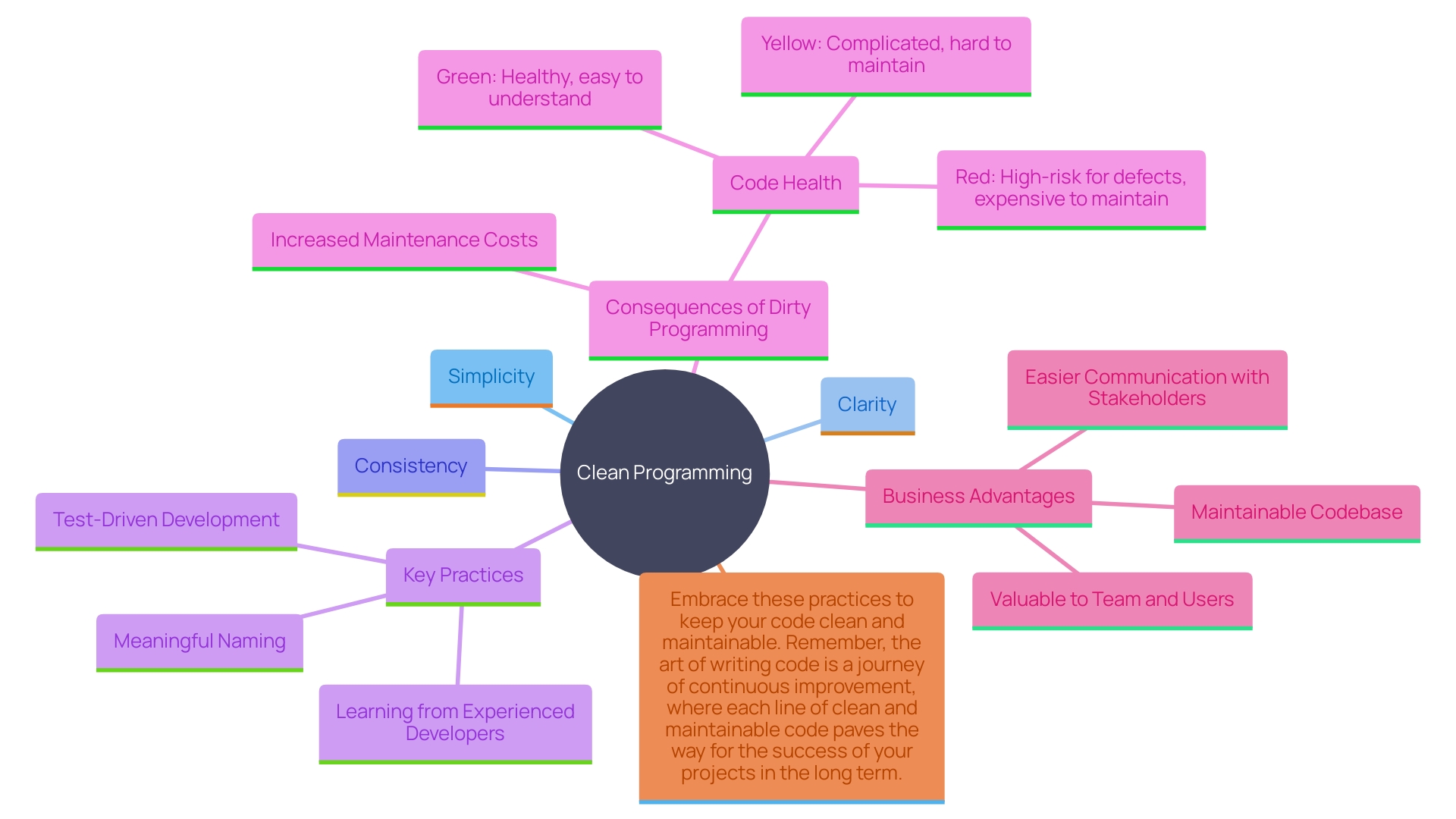
Meaningful Naming Conventions
Choosing meaningful names for variables, functions, and classes is essential in programming. Names ought to distinctly indicate their function and application, converting the program into self-explanatory artifacts. For instance, substituting a vague variable name such as x with total Amount instantly conveys its intended use, enhancing the clarity of the program. This practice is not merely a matter of preference but a cornerstone of clarity, understanding, and collaboration. Research shows that experienced developers tend to use longer, more descriptive names, which significantly improves comprehension. Avoiding single-letter or ambiguous names like x or y helps prevent confusion and errors, making the codebase more maintainable. In fact, a recent study highlighted that descriptive naming conventions lead to better code quality and efficiency, underscoring the importance of this practice in software development.
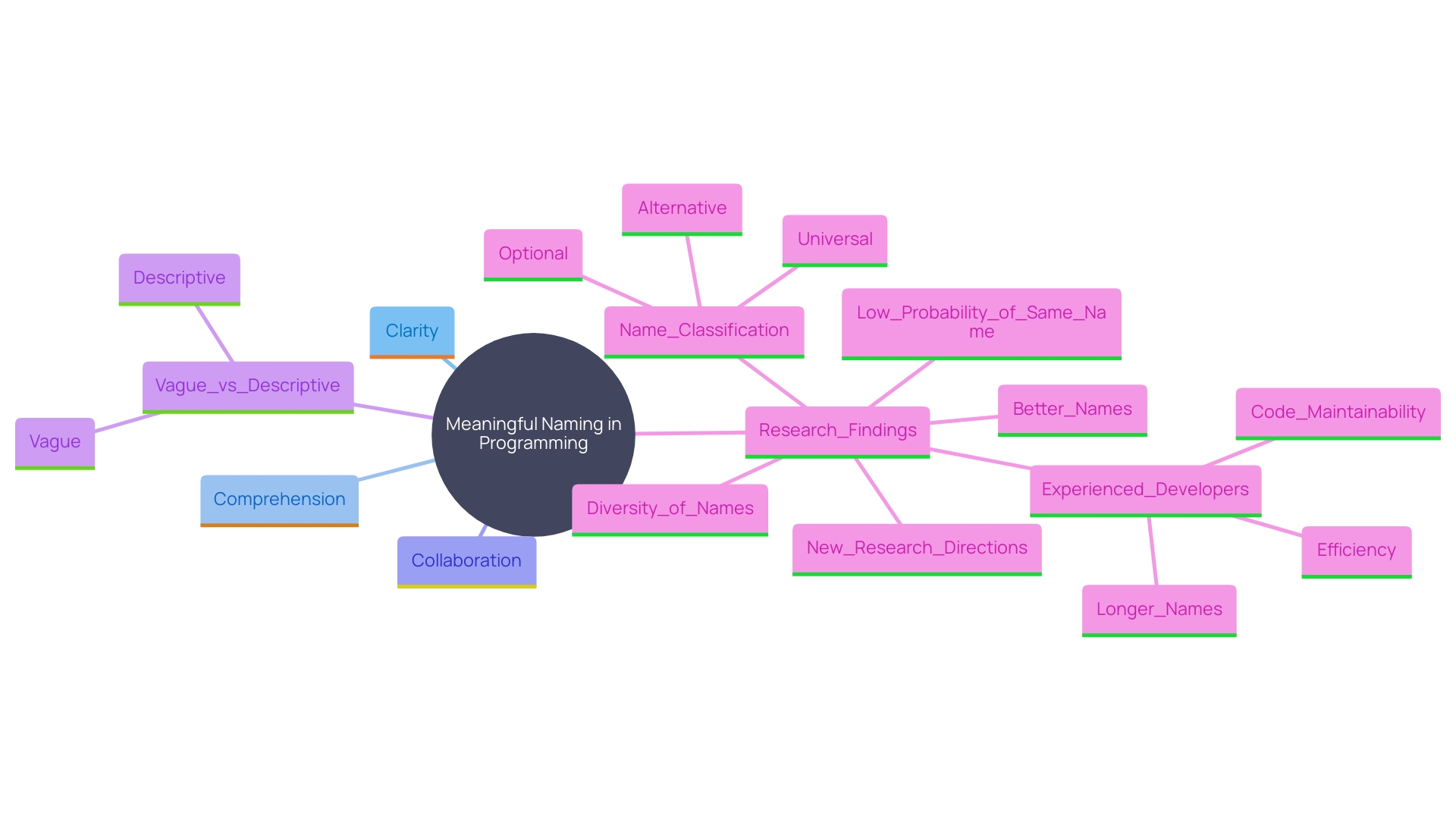
Keeping Functions and Methods Concise
Brief procedures and techniques are crucial for improving clarity and minimizing mental effort. When each procedure accomplishes a single task and is kept brief, it promotes better organization and simpler future modifications. Mastering the art of crafting clean, elegant, and maintainable routines is a cornerstone of effective coding.
Each procedure should follow the principles of performing one task, keeping a single level of abstraction, and reducing both the amount of text and the number of parameters provided. As the celebrated software developer pointed out, 'Each procedure should perform One Thing, maintain a Single Level of Abstraction, and Minimize both the amount of text and the number of parameters passed.'
'Using Python as an example, the language's syntax is designed to be clear and expressive, allowing for concise programming through features like lambda functions, ternary operators, and list comprehensions.'. Here’s a Python one-liner: result = [x**2 for x in range(10) if x % 2 == 0]. This illustrates how concise programming can be both powerful and understandable.
Refactoring plays a crucial role in maintaining clean programming. Techniques such as correcting composing methods by removing duplication and breaking down complex methods into smaller pieces are vital. Regularly scheduled refactoring ensures that your programming remains clean and efficient.
The business advantage of a healthy software foundation is clear: tasks can take up to ten times longer when working with unhealthy systems compared to healthy ones. This efficiency can be the difference between months of progress and a few weeks.
Remember, by leveraging functions effectively, you can write cleaner, more maintainable, and efficient programming, allowing you to build more complex and robust applications. The journey to becoming a proficient coder starts with these fundamental building blocks.
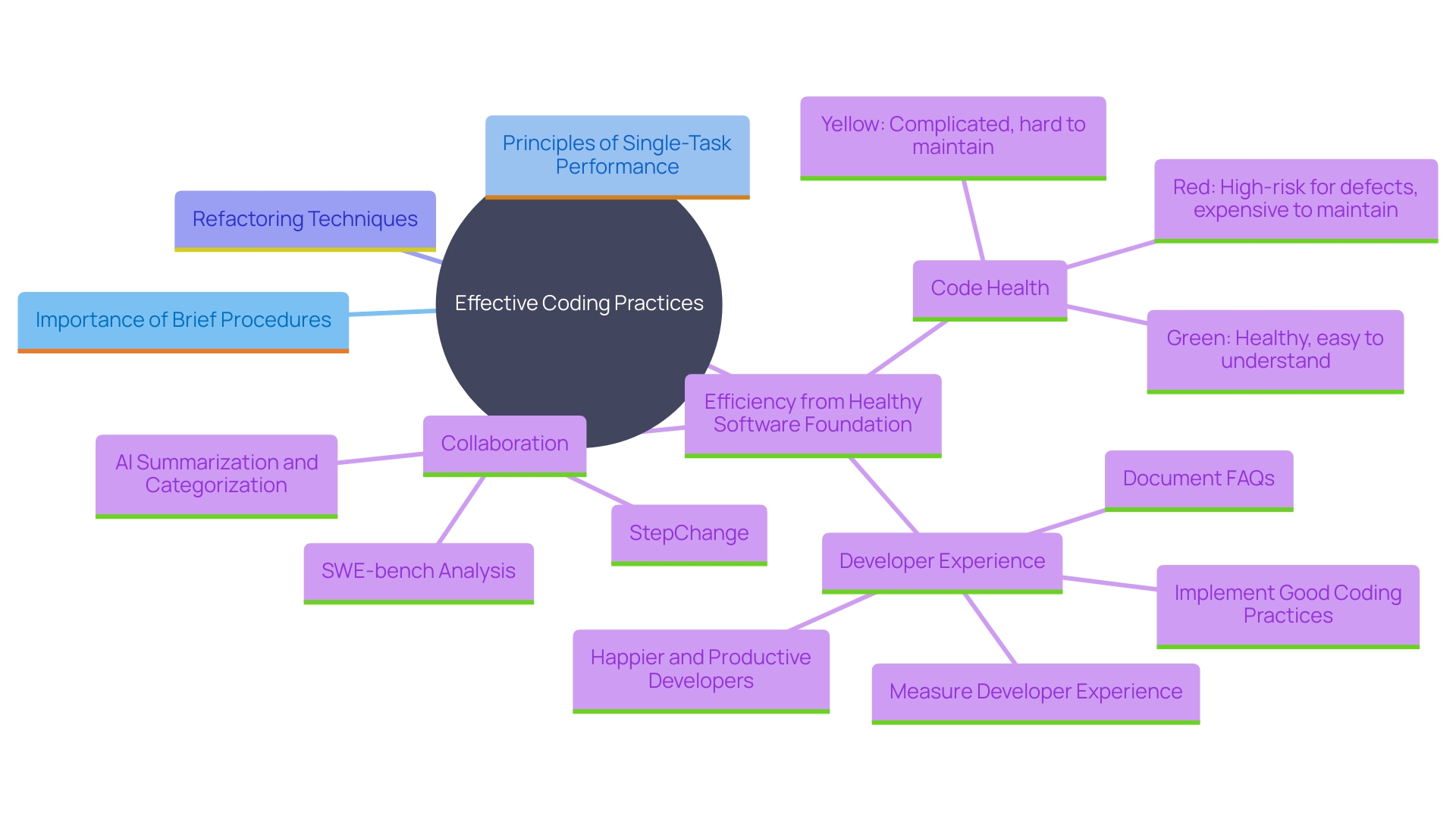
Embracing the DRY (Don't Repeat Yourself) Principle
The DRY (Don't Repeat Yourself) principle is crucial in software development for improving the quality and maintainability of programs. By minimizing repetition in programming, it significantly reduces the risk of errors and simplifies maintenance. When the same programming instructions are scattered across multiple locations, updates become cumbersome and error-prone. Instead, common functionalities should be abstracted into reusable components or functions, ensuring that changes are centralized and efficient.
Andrew Hunt and David Thomas, who developed the DRY principle, stress that reusing components wherever possible makes the system easier and quicker to modify. This modular approach aligns with Clean Architecture, promoting software reuse through a structured separation of concerns.
Furthermore, a recent study analyzing over 150 million lines of modifications showed that churn and reduced reuse are concerning trends. This highlights the significance of following DRY guidelines to uphold high programming quality and avoid the emergence of programming odors.
Embracing DRY concepts not only simplifies the development process but also conforms to the KISS (Keep It Simple, Stupid) design philosophy. Simple designs are easier to understand, maintain, and modify, leading to more reliable and efficient software. As mentioned in the tech community, "DRY is a well-known and fundamental principle in the programming industry that emphasizes reusing elements as much as possible." By integrating DRY with other clean coding practices, developers can create robust and scalable systems.
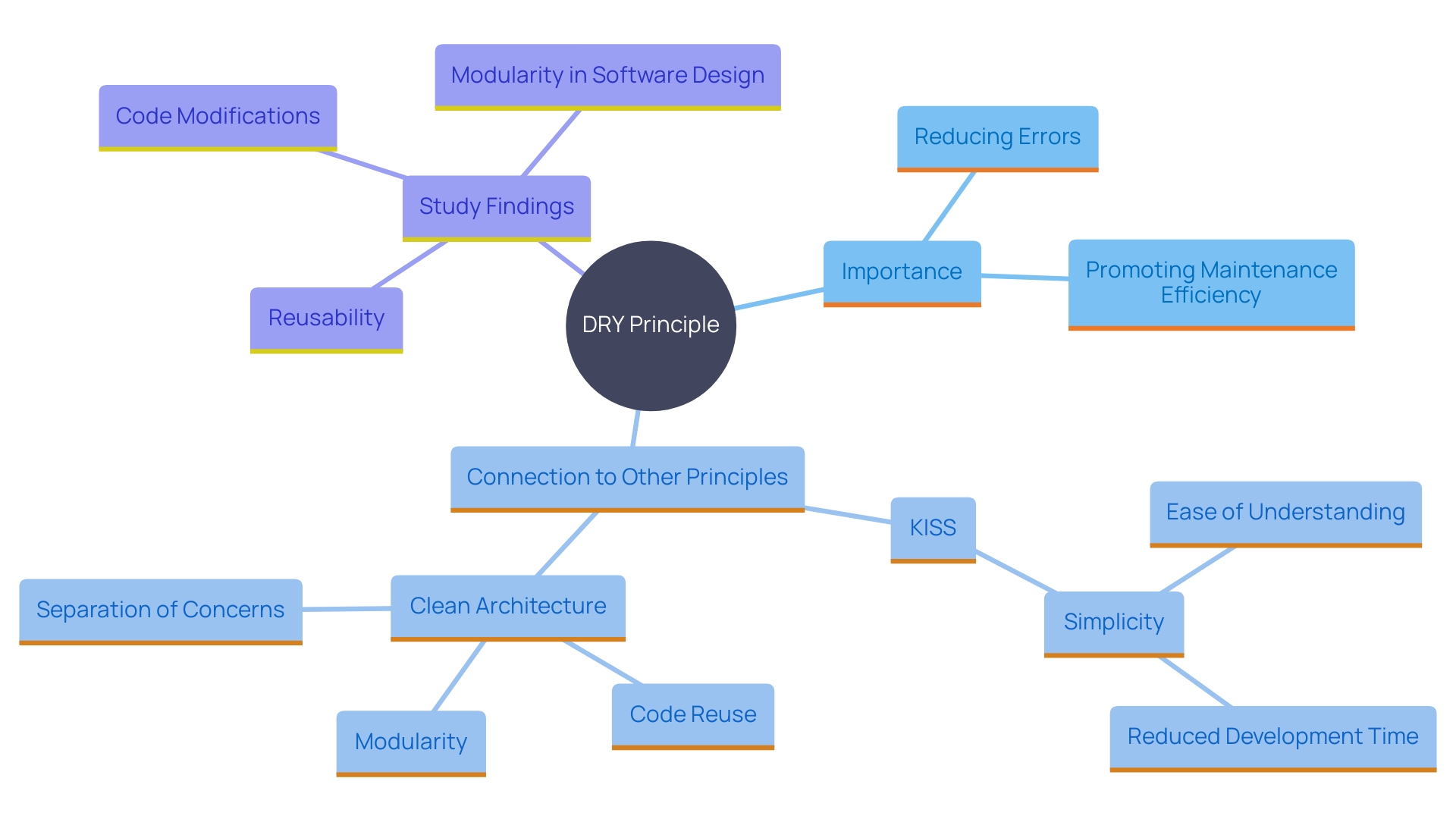
Effective Documentation
Clear and concise documentation is crucial for guiding future developers and maintaining your codebase. Comments should be used wisely to clarify the 'why' behind complex logic, ensuring they provide value without stating the obvious. Effective documentation enhances the programming elements, making it easier to navigate and comprehend. As programming documentation is a craft, it requires attention, care, and commitment. By following these principles, you can create documentation that not only serves as a reliable guide but also fosters collaboration and understanding within development teams. For instance, instead of merely describing what a piece of programming does, explain the reasoning behind it. This approach helps other developers quickly grasp the essentials of your codebase, avoiding the pitfalls of redundant or overwhelming documentation. Embrace the balance between providing sufficient information and avoiding unnecessary details to make your documentation more likely to be read and understood.
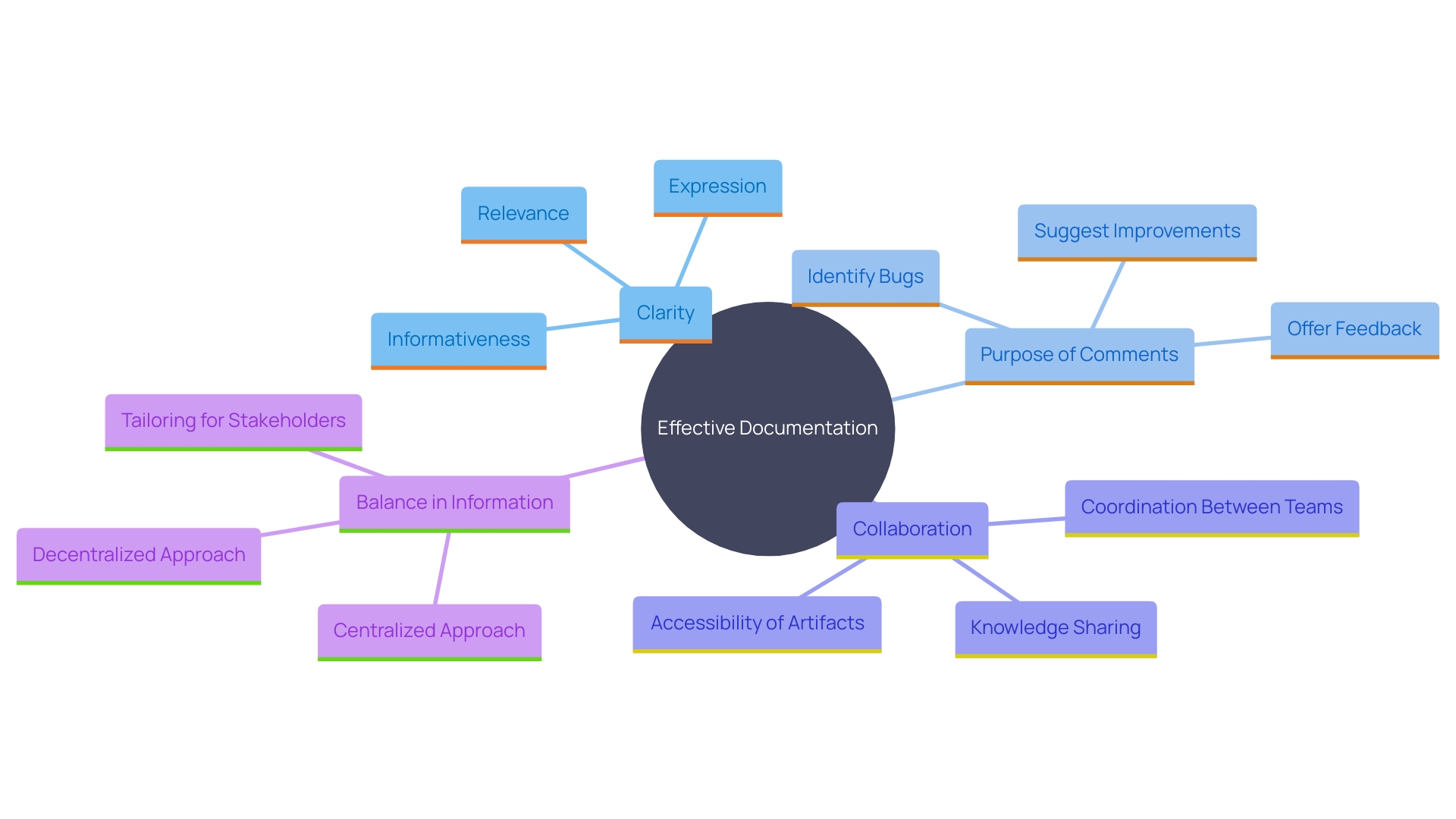
Common Mistakes to Avoid in Clean Code Development
Mastering clean coding requires vigilance against common pitfalls, such as excessive comments, unclear abbreviations, and neglecting to refactor. Excessive commenting can clutter your program, making it harder to read and maintain. Instead, strive for self-explanatory scripts by using meaningful names and simplifying complex logic. For instance, steer clear of placeholders such as 'foo' and choose descriptive variable names that make the program intuitive for any developer who may examine or engage with it in the future.
Unclear abbreviations can lead to misunderstandings and errors. Always use clear, consistent naming conventions to enhance readability and maintainability. Refactoring is another essential practice; it involves restructuring existing programs to enhance their quality without changing their functionality. Techniques like extracting methods or breaking down large functions into smaller, focused components can make your codebase more resilient and easier to navigate.
Incorporating unit tests ensures each part of your program works as expected, aligning with best practices and programming standards. Instruments such as static analysis tools and linters can assist in upholding these standards, fostering ongoing education and enhancement. A real-world example involves a team adopting a new coding standard and using a linter to enforce it. Initially, the linter flagged many issues, but as team members corrected these, they learned more about the standard and began writing cleaner programs from the start. This process not only reduced linter issues over time but also led to more efficient development cycles and a higher quality codebase.
By adhering to these principles, you not only enhance the readability and maintainability of your work but also contribute to a smoother collaboration within your team. Clean code is a continuous journey of learning and improvement, ensuring long-term success for your projects.
Conclusion
The principles of clean code are essential for fostering readability, maintainability, and efficiency in software development. By prioritizing simplicity and clarity, developers can significantly reduce complexity and enhance the overall quality of their code. Meaningful naming conventions play a crucial role in transforming code into self-documenting artifacts, while concise functions and adherence to the DRY principle streamline the development process and minimize errors.
Effective documentation is vital for guiding future developers, ensuring that the reasoning behind complex logic is clearly communicated. Avoiding common pitfalls, such as excessive comments and unclear abbreviations, further reinforces the integrity of the codebase. Incorporating unit tests and utilizing static code analyzers not only improves code quality but also supports continuous learning and improvement within development teams.
Incorporating these practices not only results in a healthier codebase but also enhances professional reputation and project success. By embracing clean coding principles, developers can achieve greater efficiency and productivity, paving the way for successful and scalable software projects. The long-term benefits are undeniable, as a commitment to clean code ultimately leads to reduced maintenance costs and accelerated development cycles, providing a competitive edge in the fast-paced world of software development.
Frequently Asked Questions
What is clean programming?
Clean programming is a coding approach focused on simplicity, clarity, and consistency. It aims to reduce complexity, making software more readable and maintainable.
Why are meaningful names important in programming?
Meaningful names for variables, functions, and classes help to clearly indicate their purpose and usage, enhancing code clarity. This practice reduces confusion and facilitates collaboration among developers.
What are some key practices for writing clean code?
Key practices include using meaningful names, keeping functions brief and focused on a single task, regularly refactoring code, and implementing test-driven development (TDD) and unit tests.
How does clean programming impact software maintenance costs?
Dirty or poorly constructed code can lead to maintenance nightmares and increased costs. More than 70% of a software's overall expense is related to upkeep, emphasizing the need for clean coding practices.
What is the significance of the DRY principle?
The DRY (Don't Repeat Yourself) principle encourages the reduction of repetitive code, which simplifies maintenance and minimizes errors. It promotes reusability and aligns with clean architecture principles.
How does documentation play a role in clean programming?
Clear documentation helps future developers understand the codebase. Effective comments should clarify the reasoning behind complex logic rather than just describing what the code does.
What are some common pitfalls to avoid in clean coding?
Common pitfalls include excessive commenting that clutters code, using unclear abbreviations, and neglecting to refactor code when necessary.
How can I ensure ongoing improvement in code quality?
To maintain high code quality, regularly incorporate practices such as refactoring, utilizing unit tests, and employing static analysis tools and linters to enforce coding standards.
What benefits do companies gain from maintaining a healthy codebase?
Companies with healthy codebases experience quicker production cycles and reduced time to complete tasks. This efficiency provides a competitive edge in the software development market.
Is clean programming a one-time effort?
No, clean programming is an ongoing process that requires continuous learning and commitment to best practices in software development.




